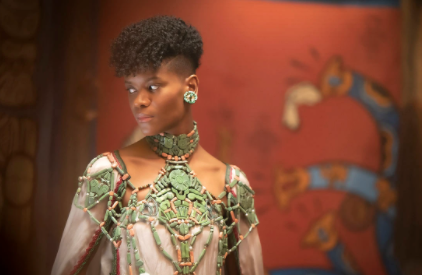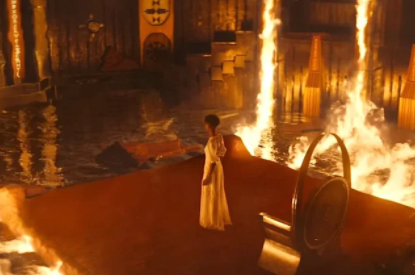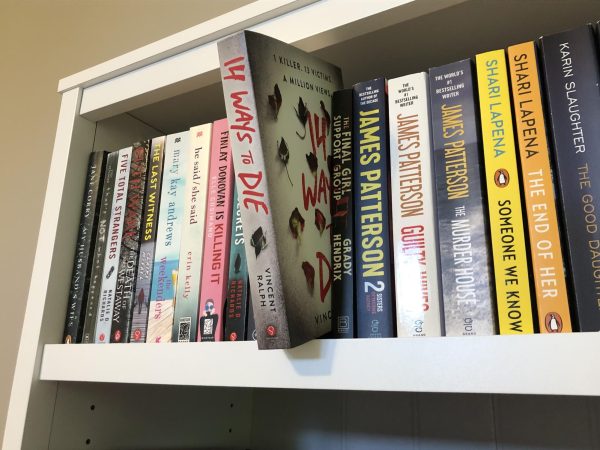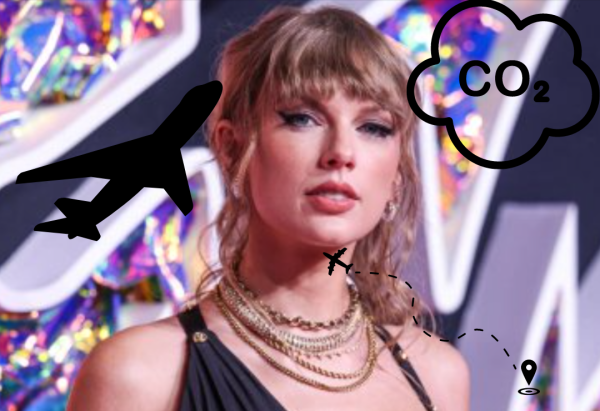‘Black Panther: Wakanda Forever’ fills a void
The newest release in the Marvel Cinematic Universe is a compelling emotional rollercoaster despite its shortcomings

Photo courtesy of Marvel Studios
Shuri’s inspiring journey through grief and loss is the driving force behind “Wakanda Forever.”
“Black Panther: Wakanda Forever” is miles away from what it was originally written to be, yet somehow is the most cohesive film released by Marvel Studios this year. Following the tragic death of Chadwick Boseman, who starred in the titular role of Black Panther and passed away in late 2020, the film had to be rewritten completely. It was delayed multiple times due to these rewrites and COVID-19, but despite the turbulence surrounding the film it has a quality recently released Marvel Studios films and shows seem to have been lacking— heart.
The amount of love and care the writers, actors, producers, and director poured into this movie is evident in every scene, especially the most poignant ones. Leading with a cold open into T’Challa’s (Boseman’s) death from Shuri’s perspective was a heart-wrenching way to start the movie that set the tone for the film. It was clear within the first five seconds that this would not be a movie focused on well timed quips and grandiose CGI action shots, instead it would be a movie focused on human emotion.
The emotional core of this film is Shuri (Letitia Wright). “Wakanda Forever” essentially functions as her origin story and highlights her journey through grief following the death of her brother T’Challa and eventually her mother Ramonda (Angela Bassett). Every decision Shuri makes throughout the film harkens back to her internal struggle with something we all experience, loss, which makes her an extremely relatable character. It’s a stark contrast to other Marvel Studios projects that have been released this past year.
Movies like “Doctor Strange in the Multiverse of Madness” and “Thor: Love and Thunder” had emotional moments, but were more focused on spectacle than character. These movies dealt with some of the same topics as “Wakanda Forever,” including grief and loss, but did not spend adequate time with these ideas. Instead, they rushed past in order to get to the next cameo or joke, which left those films feeling half-baked.

On the other hand, “Wakanda Forever” leaves something to be desired in the action department, but feels like an emotionally complete film. Shuri experiences clear emotional character growth throughout the film in a way the heroes of the most recent Doctor Strange and Thor movies did not. She learns and grows as a person, finally finding a way to fill the shoes her brother and mother left behind. Watching Shuri find a way to move on while balancing the weight of the world on her shoulders is inspiring and makes viewers invested in her as a character unlike other recent Marvel Studios films.
None of the emotional moments that make this film so good would have been possible without the talents of Wright and Bassett. The two actresses were standouts throughout the film and their passion for the project shone through in every moment they were on screen, especially together. The mother-daughter relationship between the characters that these actresses play was beautifully complex and portrayed extremely well.
The weakest portions of “Wakanda Forever” were a symptom of a larger and common Marvel Studios problem, its villain was confusing and two dimensional. The primary villain, Namor (Tenoch Huerta), had a compelling backstory, but the logic behind it was hard to understand. Why would he wait so long to attack the surface world if he was so bitter about the crimes that had been committed against his people? Namor had 600 years to build an army that he claimed was sufficient to destroy the surface world, so why not do it sometime within those 600 years? The side villains had no personality whatsoever and their skin color changing depending on whether they were in or out of the water was a strange choice that made it hard to tell who was who in vs. out of the water.
As a whole, “Black Panther: Wakanda Forever” is not better than its predecessor, as its weakest point was the first Black Panther movie’s strong point. Killmonger was one of the best Marvel Studios villains in general, and while Namor was a fine villain, he lacked the third dimension that Killmonger brought to “Black Panther.” “Wakanda Forever” is, however, a fundamentally good movie that is worth a trip to see in theaters. It may not be a top 10 Marvel Studios movie, but it is miles more compelling than anything else the studio has released this year.
For more discussion of “Black Panther: Wakanda Forever” and other recent Disney movies and television shows listen to the most recent episode of the West Linn Weekly Wake Up.
Your donation will support the student journalists of West Linn High School. Your contribution will allow us to continue to produce quality content by purchasing equipment, software, and continuing to host our website on School Newspapers Online (SNO).

Audrey Lippert is a senior at West Linn High School. This is her fourth year taking journalism, and Lippert most enjoys writing current events articles,...

When she's not writing for wlhsNOW.com and the Amplifier, Karina Rower, senior, enjoys working to promote diversity with Affinity Club and volunteering...

























![Game, set, and match. Corbin Atchley, sophomore, high fives Sanam Sidhu, freshman, after a rally with other club members. “I just joined [the club],” Sidhu said. “[I heard about it] on Instagram, they always post about it, I’ve been wanting to come. My parents used to play [net sports] too and they taught us, and then I learned from my brother.”](https://wlhsnow.com/wp-content/uploads/2024/03/MG_7715-2-1200x800.jpg)
![At the bottom of the third inning, the Lions are still scoreless. Rowe stands at home plate, preparing to bat, while Vandenbrink stands off to the side as the next batter up. Despite having the bases loaded, the team was unable to score any runs. “It’s just the beginning of the season. We’re just going to be playing out best by June, [and] that’s where champions are,” Rowe said.](https://wlhsnow.com/wp-content/uploads/2024/03/IMG_3077-1200x900.jpg)





![The teams prepare to start another play with just a few minutes left in the first half. The Lions were in the lead at halftime with a score of 27-0. At half time, the team went back to the locker rooms. “[We ate] orange slices,” Malos said. “[Then] our team came out and got the win.”](https://wlhsnow.com/wp-content/uploads/2023/10/IMG_2385-1200x800.jpg)
















































































